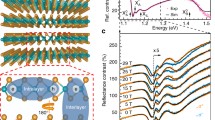Abstract
A tight-binding theory is elaborated for multilayer semiconductor heterostructures of type II in which the states of electrons and holes are dimensionally quantized in adjacent layers and overlap in a narrow region near the interface. The major effort is focused on the calculation of linear photoluminescence polarization induced by the anisotropy of chemical bonds on the ideal interface under the radiation along the axis of growth. An expression for the matrix element of the optical transition on the type-II interface under arbitrary polarization of the emitted photon is obtained. The treatment is based on the sp 3 tight-binding model. The effect of the interface tight-binding parameters considered as free ones on the linear photoluminescence polarization is analyzed. The theory allows for the giant linear photoluminescence polarization discovered in the ZnSe/BeTe heterostructure; it also predicts that the polarization plane usually coincides with the plane containing the chemical bonds at the heterojunction.
Similar content being viewed by others
References
O. Krebs and P. Voisin, Phys. Rev. Lett. 77, 1829 (1996).
O. Krebs, W. Seidel, J. P. André, et al., Semicond. Sci. Technol. 12, 938 (1997).
O. Krebs, D. Rondi, J. L. Gentner, et al., Phys. Rev. Lett. 80, 5770 (1998).
E. L. Ivchenko, A. A. Toropov, and P. Voisin, Fiz. Tverd. Tela (St. Petersburg) 40, 1925 (1998) [Phys. Solid State 40, 1748 (1998)].
A. A. Toropov, E. L. Ivchenko, O. Krebs, et al., Phys. Rev. B 63, 035 302 (2001).
E. L. Ivchenko, A. Yu. Kaminskii, and I. L. Aleiner, Zh. Éksp. Teor. Fiz. 104, 3401 (1993) [JETP 77, 609 (1993)].
D. Vignaud, X. Wallart, F. Mollot, and B. Sermage, J. Appl. Phys. 84, 2138 (1998).
F. Fuchs, J. Schmitz, J. D. Ralston, et al., Superlattices Microstruct. 16, 35 (1994).
F. Fuchs, J. Schmitz, and N. Herres, in Proceedings of the 23rd International Conference on Physics of Semiconductors, Ed. by M. Scheffler and R. Zimmermann (World Scientific, Singapore, 1996), Vol. 3, p. 1803.
A. V. Platonov, V. P. Kochereshko, E. L. Ivchenko, et al., Acta Phys. Pol. A 94, 479 (1998).
A. V. Platonov, V. P. Kochereshko, E. L. Ivchenko, et al., Phys. Rev. Lett. 83, 3546 (1999).
D. R. Yakovlev, E. L. Ivchenko, V. P. Kochereshko, et al., Phys. Rev. B 61, 2421 (2000).
M. Schmidt, M. Grün, S. Petillon, et al., Appl. Phys. Lett. 77, 85 (2000).
O. Krebs and P. Voisin, Phys. Rev. B 61, 7265 (2000).
P. O. Löwdin, J. Chem. Phys. 18, 365 (1950).
P. Vogl, H. P. Hjalmarson, and J. D. Dow, J. Phys. Chem. Solids 44, 365 (1983).
J. M. Jancu, R. Scholz, F. Beltram, and F. Bassani, Phys. Rev. B 57, 6493 (1998).
Y.-C. Chang, Phys. Rev. B 25, 605 (1982).
D. J. Stukel, Phys. Rev. B 2, 1852 (1970).
M. Nagelstrasser, H. Dröge, H.-P. Steinrück, et al., Phys. Rev. B 58, 10 394 (1998).
M. Cruz, M. R. Beltran, C. Wang, et al., Phys. Rev. B 59, 15 381 (1999).
T. G. Pedersen, K. Pedersen, and T. B. Kriestensen, Phys. Rev. B 63, 201101 (2001).
L. C. Lew Yan Voon and L. R. Ram-Mohan, Phys. Rev. B 47, 15 500 (1993).
M. Graf and P. Vogl, Phys. Rev. B 51, 4940 (1995).
P. V. Santos, P. Etchegoin, M. Cardona, et al., Phys. Rev. B 50, 8746 (1994).
T. Dumitric, J. S. Graves, and R. E. Allen, Phys. Rev. B 58, 15 340 (1998).
Y.-C. Chang and J. N. Schulman, Phys. Rev. B 31, 2069 (1985).
Y.-C. Chang and D. E. Aspnes, Phys. Rev. B 41, 12 002 (1990).
G. D. Sanders and Y.-C. Chang, Phys. Rev. B 45, 9202 (1992).
Z. Xu, Solid State Commun. 76, 1143 (1990)
L. M. Ramaniah and S. V. Nair, Phys. Rev. B 47, 7132 (1993).
A. Selloni, P. Marsella, and R. Del Sole, Phys. Rev. B 33, 8885 (1986).
Author information
Authors and Affiliations
Additional information
__________
Translated from Zhurnal Éksperimental’no\(\overset{\lower0.5em\hbox{$\smash{\scriptscriptstyle\smile}$}}{l} \) i Teoretichesko\(\overset{\lower0.5em\hbox{$\smash{\scriptscriptstyle\smile}$}}{l} \) Fiziki, Vol. 121, No. 3, 2002, pp. 747–757.
Original Russian Text Copyright © 2002 by Ivchenko, Nestoklon.
Rights and permissions
About this article
Cite this article
Ivchenko, E.L., Nestoklon, M.O. Optical transitions on a type II semiconductor interface in the empirical tight-binding theory. J. Exp. Theor. Phys. 94, 644–653 (2002). https://doi.org/10.1134/1.1469162
Received:
Issue Date:
DOI: https://doi.org/10.1134/1.1469162




